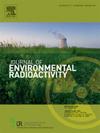利用惰性气体和气溶胶样本进行源项估算
IF 1.9
3区 环境科学与生态学
Q3 ENVIRONMENTAL SCIENCES
引用次数: 0
摘要
利用远程采样的空气浓度估算点源大气释放的位置、时间和规模的算法通常使用单一化学或放射性同位素的数据。本文介绍了一种贝叶斯算法,该算法使用在同一短时事件中释放的多种放射性同位素数据。模型可同时使用惰性气体和气溶胶采样器的数据。对使用四种同位素的大型合成数据集的应用表明,与使用单一同位素的同类模型相比,新算法通常能提供更准确的位置和时间估计。本文章由计算机程序翻译,如有差异,请以英文原文为准。
Source term estimation using noble gas and aerosol samples
Algorithms that estimate the location, time, and magnitude of a point-source atmospheric release using remotely sampled air concentrations typically use data for a single chemical or radioactive isotope. A Bayesian algorithm is presented that uses data from multiple radioactive isotopes that are all released in the same short-duration event. Data from noble gas and aerosol samplers can be used simultaneously in the model. Application to a large synthetic data set using four isotopes shows the new algorithm generally gives more accurate location and time estimates than a comparable model using a single isotope.
求助全文
通过发布文献求助,成功后即可免费获取论文全文。
去求助
来源期刊

Journal of environmental radioactivity
环境科学-环境科学
CiteScore
4.70
自引率
13.00%
发文量
209
审稿时长
73 days
期刊介绍:
The Journal of Environmental Radioactivity provides a coherent international forum for publication of original research or review papers on any aspect of the occurrence of radioactivity in natural systems.
Relevant subject areas range from applications of environmental radionuclides as mechanistic or timescale tracers of natural processes to assessments of the radioecological or radiological effects of ambient radioactivity. Papers deal with naturally occurring nuclides or with those created and released by man through nuclear weapons manufacture and testing, energy production, fuel-cycle technology, etc. Reports on radioactivity in the oceans, sediments, rivers, lakes, groundwaters, soils, atmosphere and all divisions of the biosphere are welcomed, but these should not simply be of a monitoring nature unless the data are particularly innovative.
 求助内容:
求助内容: 应助结果提醒方式:
应助结果提醒方式:


